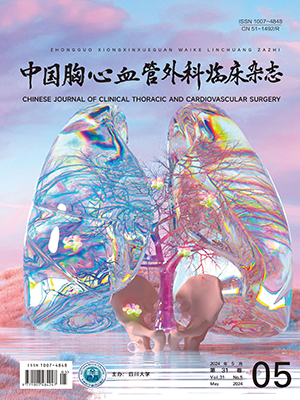| 1. |
Popma JJ, Deeb GM, Yakubov SJ, et al. Transcatheter aortic-valve replacement with a self-expanding valve in low-risk patients. N Engl J Med, 2019, 380(18): 1706-1715.
|
| 2. |
Thyregod HG, Sondergaard L, Ihlemann N, et al. The Nordic Aortic Valve Intervention (NOTION) trial comparing transcatheter versus surgical valve implantation: Study protocol for a randomised controlled trial. Trials, 2013, 14: 11.
|
| 3. |
hyregod HGH, Ihlemann N, Jørgensen TH, et al. Five-year clinical and echocardiographic outcomes from the Nordic Aortic Valve Intervention (NOTION) randomized clinical trial in lower surgical risk patients. Circulation, 2019. [Epub ahead of print].
|
| 4. |
Mack M J, Leon M B, Thourani V H, et al. Transcatheter aortic-valve replacement with a balloon-expandable valve in low-risk patients. N Engl J Med, 2019, 380(18): 1695-1705.
|
| 5. |
Thiele H, Kurz T, Feistritzer H J, et al. Comparison of newer generation self-expandable vs. balloon-expandable valves in transcatheter aortic valve implantation: The randomized SOLVE-TAVI trial. Eur Heart J, 2020, 41(20): 1890-1899.
|
| 6. |
Webb J, Wood D, Sathananthan J, et al. Balloon-expandable or self-expandable transcatheter heart valves. Which are best? Eur Heart J, 2020, 41(20): 1900-1902.
|
| 7. |
Otto CM, Nishimura RA, Bonow RO, et al. 2020 ACC/AHA guideline for the management of patients with valvular heart disease: A report of the American College of Cardiology/American Heart Association Joint Committee on Clinical Practice Guidelines. J Am Coll Cardiol, 2021, 77(4): e25-e197.
|
| 8. |
Braghiroli J, Kapoor K, Thielhelm TP, et al. Transcatheter aortic valve replacement in low risk patients: A review of PARTNER 3 and Evolut Low Risk trials. Cardiovasc Diagn Ther, 2020, 10(1): 59-71.
|
| 9. |
Kapadia SR, Leon MB, Makkar RR, et al. 5-year outcomes of transcatheter aortic valve replacement compared with standard treatment for patients with inoperable aortic stenosis (PARTNER 1): A randomised controlled trial. Lancet, 2015, 385(9986): 2485-2491.
|
| 10. |
Mack MJ, Leon MB, Smith CR, et al. 5-year outcomes of transcatheter aortic valve replacement or surgical aortic valve replacement for high surgical risk patients with aortic stenosis (PARTNER 1): A randomised controlled trial. Lancet, 2015, 385(9986): 2477-2484.
|
| 11. |
Pibarot P, Ternacle J, Jaber WA, et al. Structural deterioration of transcatheter versus surgical aortic valve bioprostheses in the PARTNER-2 trial. J Am Coll Cardiol, 2020, 76(16): 1830-1843.
|
| 12. |
Roberts WC, Ko JM. Frequency by decades of unicuspid, bicuspid, and tricuspid aortic valves in adults having isolated aortic valve replacement for aortic stenosis, with or without associated aortic regurgitation. Circulation, 2005, 111(7): 920-925.
|
| 13. |
Li Y, Wei X, Zhao Z, et al. Prevalence and complications of bicuspid aortic valve in Chinese according to echocardiographic database. Am J Cardiol, 2017, 120(2): 287-291.
|
| 14. |
Vincent F, Ternacle J, Denimal T, et al. Transcatheter aortic valve replacement in bicuspid aortic valve stenosis. Circulation, 2021, 143(10): 1043-1061.
|
| 15. |
Sa M, Simonato M, Van den Eynde J, et al. Asymptomatic severe aortic stenosis, bicuspid aortic valves and moderate aortic stenosis in heart failure: New indications for transcatheter aortic valve implantation. Trends Cardiovasc Med, 2020. [Epub ahead of print].
|
| 16. |
中华医学会心血管病学分会结构性心脏病学组. 经导管主动脉瓣置换术治疗二叶式主动脉瓣狭窄的中国专家建议. 中华心血管病杂志, 2020, 48(8): 634-640.
|
| 17. |
Goel SS, Ige M, Tuzcu EM, et al. Severe aortic stenosis and coronary artery disease-implications for management in the transcatheter aortic valve replacement era: A comprehensive review. J Am Coll Cardiol, 2013, 62(1): 1-10.
|
| 18. |
Kvidal P, Bergström PR, Hörte LG, et al. Observed and relative survival after aortic valve replacement. J Am Coll Cardiol, 2000, 35(3): 747-756.
|
| 19. |
Abdelghani M, Landt M, Traboulsi H, et al. Coronary access after TAVR with a self-expanding bioprosthesis: Insights from computed tomography. JACC Cardiovasc Interv, 2020, 13(6): 709-722.
|
| 20. |
Arshi A, Yakubov SJ, Stiver KL, et al. Overcoming the transcatheter aortic valve replacement Achilles heel: Coronary re-access. Ann Cardiothorac Surg, 2020, 9(6): 468-477.
|
| 21. |
Faroux L, Lhermusier T, Vincent F, et al. ST-segment elevation myocardial infarction following transcatheter aortic valve replacement. J Am Coll Cardiol, 2021, 77(17): 2187-2199.
|
| 22. |
Tang GHL, Zaid S, Fuchs A, et al. Alignment of transcatheter aortic-valve neo-commissures (ALIGN TAVR): Impact on final valve orientation and coronary artery overlap. JACC Cardiovasc Interv, 2020, 13(9): 1030-1042.
|




